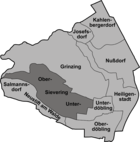Sievering
Obersievering and Untersievering arose when the winegrowing subjects of local landowners settled around the Meierhöfe in both towns.
They were mentioned in 1330 for the first time as separate settlements under the names Ober-Sufferingen and Under-Sufferingen; it is not clear which of the two arose first.
The modern-day Katastralgemeinden Untersievering and Obersievering cover a total area of 433.04 hectares, although the border of these Katastralgemeinden does not concur precisely with that of the area given the name Sievering in statistical analyses conducted by the Austrian government, which also consists of two smaller units.
A link was probably made to Saint Severinus of Noricum in the Middle Ages, who is believed to have been a missionary in the area at the start of this period.
At the time of the Roman Empire, there was a large quarry in Sievering, from which stones were used in the construction of the military base Vindobona.
In the following decades, Obersievering developed much less rapidly than Untersievering as a result of its cooler, moister climate and poor transport links.
When they were integrated into the city of Vienna in 1892 together with Unterdöbling, Oberdöbling, Heiligenstadt, Nußdorf, Grinzing, Josefsdorf and Kahlenbergerdorf, Obersievering had 626 inhabitants and Untersievering 1,996.
Around 1900, large apartment blocks were thrown up in the lower Sieveringer Straße, and the surrounding hills were gradually built over.
Unlike nearby Grinzing or Neustift am Walde, Sievering was not considered an attractive summer destination and grapes grew more slowly in the cool valley than on the surrounding hilltops.
Nonetheless, factories were gradually established here as well and in 1837 a wagon line connected Sievering with Vienna for the first time.
In 1897, carpenter Wenzl Hartl founded a noteworthy steam-driven sawmill at number 2 in the Sieveringer Straße.
It was however the automobile factory Gräf & Stift that held the title as the largest enterprise in Sievering.



